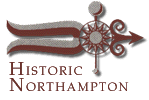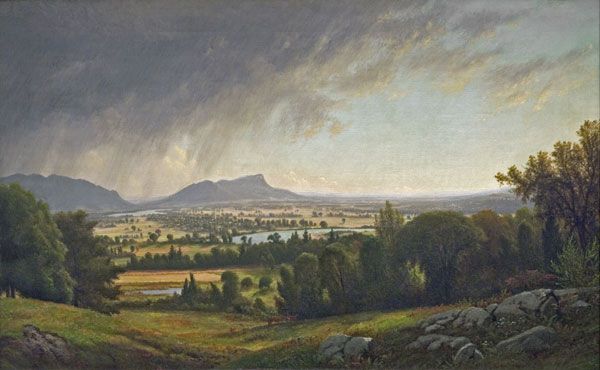
Archives & Manuscripts Costumes & Textiles Daguerreotypes & Photographs Decorative Arts Fine Art Other Collections Furniture Digital Collections 
|


Northampton Meadows
 |
Northampton Meadows, 1864 Edward W. Nichols (1819-1871) Photograph by Stan Sherer |
The painting, Northampton Meadows, was donated to Historic Northampton in 1939 by Emily Hale, whose father, William Hale, former president of the First National Bank, owned the painting. Information on the artist, Edward Nichols, was scarce until a June 2010 article in Fine Art Connoisseur magazine, "Edward W. Nichols and the Image of an Ideal America" written by Ann Y. Smith, former director and curator at the Mattatuck Museum and the Florence Griswold Museum, both in Connecticut. The article was dedicated to Howard Merritt (1915-2007), a professor of art history at the University of Rochester, who discovered Nichols’ work at age 6 in the attic of his childhood home, previously the home of Nichols’ son. Merritt’s scholarship is recognized by Ann Y. Smith as the foundation for research on Edward Nichols. Billie MacGregor, former trustee of Historic Cherry Hill, also conducted extensive research on Nichols. Below is biographical information extracted from the article.
Edward Nichols was born on April 23, 1819 in Orford, New Hampshire, a prosperous trading village on the Connecticut River. He taught sacred music until age 23 and then studied law in Burlington, Vermont. In 1851, at age 32, he abandoned his law career to become a landscape painter. Moving to New York that year, he enrolled in the antique class at the National Academy and studied with the landscape painter Jasper Cropsey (1823-1900). In 1853, he exhibited three landscapes at the Academy. In spring 1853, he married Maria Watkinson (1817-1885), daughter of the Hartford merchant and iron trader Edward Watkinson (1783-1841) and Lavinia Hudson Watkinson. Maria had previously worked as a volunteer teacher in missionary schools in Beirut and Constantinople.
Edward and Maria traveled in England, France, Austria, and Italy where Edward made pencil sketches of architecture and landscape, annotated to indicate color and texture. 265 sketches and drawings are now preserved in the Shelburne Museum, Vermont. Many are identified by date and location. Nichols sketched on site at Kenilworth and Warwick castles in England, at Neuchatel in Switzerland, and in Rome and Sicily. He also studied European collections, such as those at the Musee du Louvre. In 1854, Edward Leamington Nichols, the couple’s only child, was born in Leamington, England. The family returned to New York the following summer.
In 1858, Nichols became a founding tenant of the Tenth Street Studio Building and remained there until 1862. Early occupants of the 23 studios included Frederic Church (1826-1900), Worthington Whittredge (1820-1910) and Martin Johnson Heade (1819-1904). Scholar Annette Blaugrund describes this building as “the headquarters of the Hudson River School of painting,” where its leading artists shared a two-story exhibition gallery equipped with gas lighting and a skylight.
Nearly 90 of Nichols’s pictures appeared in prominent exhibitions in New York, Brooklyn, Boston, Philadelphia, Chicago, Utica, Providence, and New Haven, where important collectors bought them. Virtually all titles indicate a specialization in landscapes, rather than portraits. Among these buyers were Col. John Jacob Astor, Lyman Magoon and Llewellyn Haskell (1815-1872), a drug importer turned real estate developer. In 1858 Nichols was elected an associate member of the Academy, though his membership lapsed after he failed to donate the required portrait. He was elected yet again in 1862, when he submitted a portrait of himself made by Elma Mary Gove, his brother’s step-daughter. He was reviewed regularly in the nation’s leading art press.
Like other landscapists in his building, he traveled each summer and autumn to settings filled with appropriate motifs, including New Hampshire’s White Mountains, Lake Champlain, Lake George, northwestern Connecticut and the Connecticut River Valley in Massachusetts. The Evening Post, New York of August 15, 1863 reported that: "E. W. Nichols is at Northampton, Mass., having been up and down the Connecticut river, drawing lines in pleasant places." Northampton Meadows signed by Edward Nichols and dated 1864 may have been the work titled Mount Tom that Nichols exhibited at the National Academy of Design that year.
In the late 1850s, Llewellyn Haskell promoted a residential community development in New Jersey using images created by Nichols. Haskell has commissioned Alexander Jackson Davis to design the project called Llewellyn Park as a community of Gothic Revival and Italianate villas in a landscape engineered to look natural. Nichols decided to commission Haskell to design a Gothic home there for his family with a large studio and moved to New Jersey.
Nichols sold his property in New Jersey and moved to a new home at Peekskill in New York’s Hudson Valley. Even when the fashion in landscape painting changed to landscapes depicting the West, the Arctic and South America, Nichols continued to paint his familiar locations such as the Presidential Range from Lunenberg, Vermont, Lake George at Tongue Mountain and October Morning on the Hudson. Nichols died at home on September 20, 1871, at age 52 of “remittent fever, after a protracted illness.”
Contents Historic Northampton.